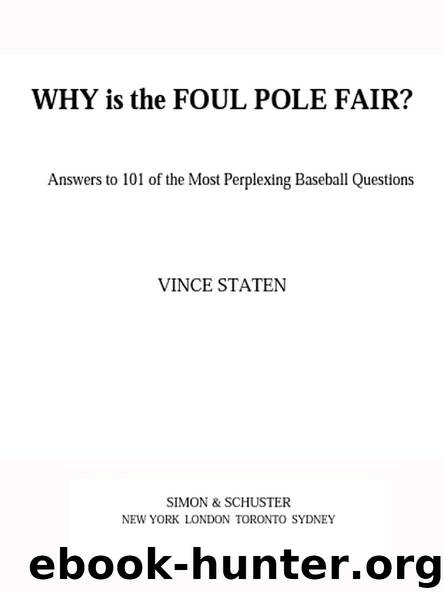WHY is the FOUL POLE FAIR? by VINCE STATEN

Author:VINCE STATEN
Language: eng
Format: epub
Publisher: SIMON & SCHUSTER
Published: 2003-07-15T00:00:00+00:00
Chapter Eight
Eye in the Sky
Julian Tavarez is pitching Sean Casey carefully in the fifth. He hasn’t forgotten the curveball that Casey drilled into left for a double in the third. With Encarnacion dancing at second and the count 0-1, Tavarez tries to slip a fastball past the batter, almost fooling Casey. The left-handed hitter swings behind the pitch, just getting under the rising ball. It soars over the backstop, smacking into the press box window and caroming back into the stands, a souvenir for a lucky little boy.
It is the only time all day that the crowd even looks in the direction of the press box. As far as the spectators are concerned, the entire cadre of writers and broadcasters is invisible, the news media held hostage behind Plexiglas. They are virtual hostages, agrees Hal McCoy, looking up from the laptop computer where he is pounding out a story for tomorrow’s edition of the Dayton Daily News. “This is the worst press box in baseball, without a doubt.”
In his 1910 book, The National Game, Alfred H. Spink, founder of the Sporting News, claimed that the first baseball beat writer was one William Cauldwell, who covered the New York Mutuals while also editing the New York Mercury in 1853. Cauldwell, who had known Walt Whitman when both worked at the New York Aurora, soon tired of reporting on baseball and editing the paper and turned over the baseball beat to Henry Chadwick.
Neither Cauldwell nor Chadwick enjoyed the benefit of covering the game from a press box. They sat in the stands with the hoi polloi and did the best they could. But soon other New York papers—the Express, the Mail, the Times, the Tribune, and the World —were staffing games and the press needed room for their notebooks. At first they were seated on the top row of the grandstand, then boxed into their own area in the stands, into an area that soon came to be known as the press box. One of the first teams to build an enclosed space for sportwriters was the Washington Olympics, who were accused by shareholders in 1870 of squandering money on a press box at their new ballpark, Olympic Grounds.
By the early years of the twentieth century, the press box was home to more than the press, with assorted interlopers and hangers-on increasingly taking up space. The situation came to a head during the 1908 playoff game in New York between the Giants and the Cubs: Chicago Examiner writer Hugh Fullerton lost his seat in the press box to Broadway actor Louis Mann, a friend of Giants manager John McGraw. Fullerton attempted to sit in Mann’s lap but ended up sitting on a box in the aisle. This disrespect continued through the World Series when the Tigers put out-of-town writers in the back row of the grandstand, and the Cubs reciprocated by putting Tiger beat writers on the roof of the first-base pavilion.
The writers had had enough and, led by Jack Ryder of the Cincinnati Enquirer and Joseph S.
Download
This site does not store any files on its server. We only index and link to content provided by other sites. Please contact the content providers to delete copyright contents if any and email us, we'll remove relevant links or contents immediately.
Machine Learning at Scale with H2O by Gregory Keys | David Whiting(3654)
Never by Ken Follett(3545)
Liar's Poker by Michael Lewis(3230)
The Ultimate Backcountry Survival Manual by Aram Von Benedikt; Editors of Outdoor Life;(3172)
Will by Will Smith(2589)
The Partner by John Grisham(2286)
Friends, Lovers, and the Big Terrible Thing by Matthew Perry(2012)
Can't Hurt Me: Master Your Mind and Defy the Odds - Clean Edition by David Goggins(2008)
Taste by Kris Bryant(1806)
HBR's 10 Must Reads 2022 by Harvard Business Review(1702)
A Short History of War by Jeremy Black(1677)
Never Finished: Unshackle Your Mind and Win the War Within by David Goggins(1562)
The Arm by Jeff Passan(1527)
515945210 by Unknown(1524)
The Dodgers by Schiavone Michael;(1478)
The Yogi Book by Yogi Berra(1426)
443319537 by Unknown(1400)
A Game of Thrones (The Illustrated Edition) by George R. R. Martin(1374)
1942266391 (N) by Monte Francis(1372)
